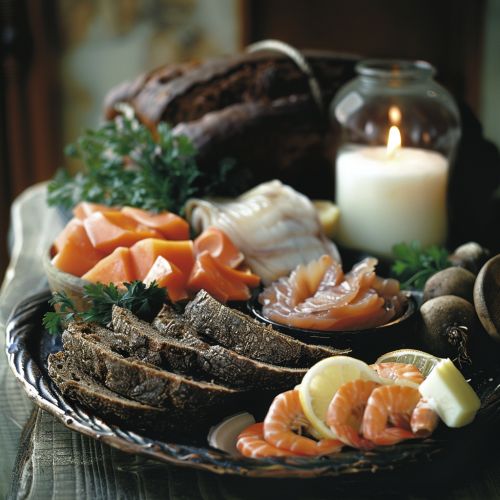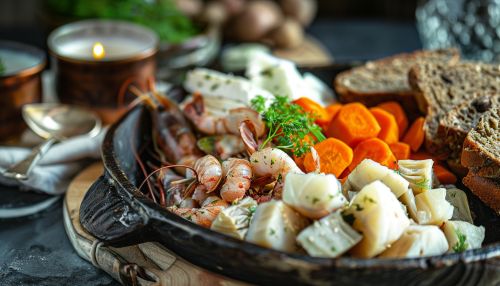Norwegian cuisine
Overview
Norwegian cuisine, a distinct and unique culinary tradition, has evolved over centuries under the influence of Norway's geography, climate, and culture. It is characterized by its use of locally sourced, high-quality ingredients, and a focus on simplicity and purity of flavors. The cuisine is heavily influenced by Norway's coastal geography, with seafood, particularly fish, playing a significant role. The country's long winters and short summers have also shaped its food culture, leading to a tradition of preserving foods through methods such as smoking, salting, and fermenting.


History
The history of Norwegian cuisine can be traced back to the Viking Age, when the diet was primarily based on farming and fishing. The Vikings were known for their seafaring skills, and they brought back a variety of foods and cooking techniques from their voyages. These included smoking and drying fish, a practice that is still prevalent in Norwegian cuisine today. The Middle Ages saw the introduction of new ingredients and dishes, such as porridge and lefse, a traditional Norwegian flatbread. The influence of the Hanseatic League in the 14th century brought in new culinary influences, including the use of spices and the art of brewing beer.
Ingredients and Dishes
Norwegian cuisine is known for its use of fresh, high-quality ingredients. Seafood, particularly fish like salmon, cod, and herring, is a staple in the diet. Meat, especially game meats like reindeer and elk, is also commonly consumed. Root vegetables, such as potatoes and carrots, are a key component of many dishes. Dairy products, including cheese and butter, are widely used.
One of the most iconic Norwegian dishes is rakfisk, a traditional dish of fermented fish. Another popular dish is lutefisk, a dried white fish treated with lye. Klippfisk, or dried and salted cod, is another traditional dish, often served with boiled potatoes and bacon. In terms of desserts, krumkake, a thin, rolled cake, and multekrem, a dessert made from cloudberries and whipped cream, are popular choices.
Regional Variations
Norwegian cuisine varies greatly by region, reflecting the country's diverse geography and climate. Coastal areas, such as the western fjords and the northern region of Finnmark, are known for their seafood dishes. Inland regions, like Oppland and Hedmark, are known for their game meats and dairy products. The cuisine of the far north, influenced by the Sami people, includes unique dishes such as bidos, a reindeer stew, and leipäjuusto, a type of cheese.
Modern Norwegian Cuisine
Modern Norwegian cuisine is characterized by a focus on locally sourced, seasonal ingredients and a fusion of traditional and contemporary cooking techniques. New Nordic Cuisine, a movement that started in the early 2000s, has had a significant impact on Norwegian food culture. This movement emphasizes the use of local, natural, and sustainable ingredients, and has led to a resurgence of interest in traditional Norwegian dishes and ingredients.
